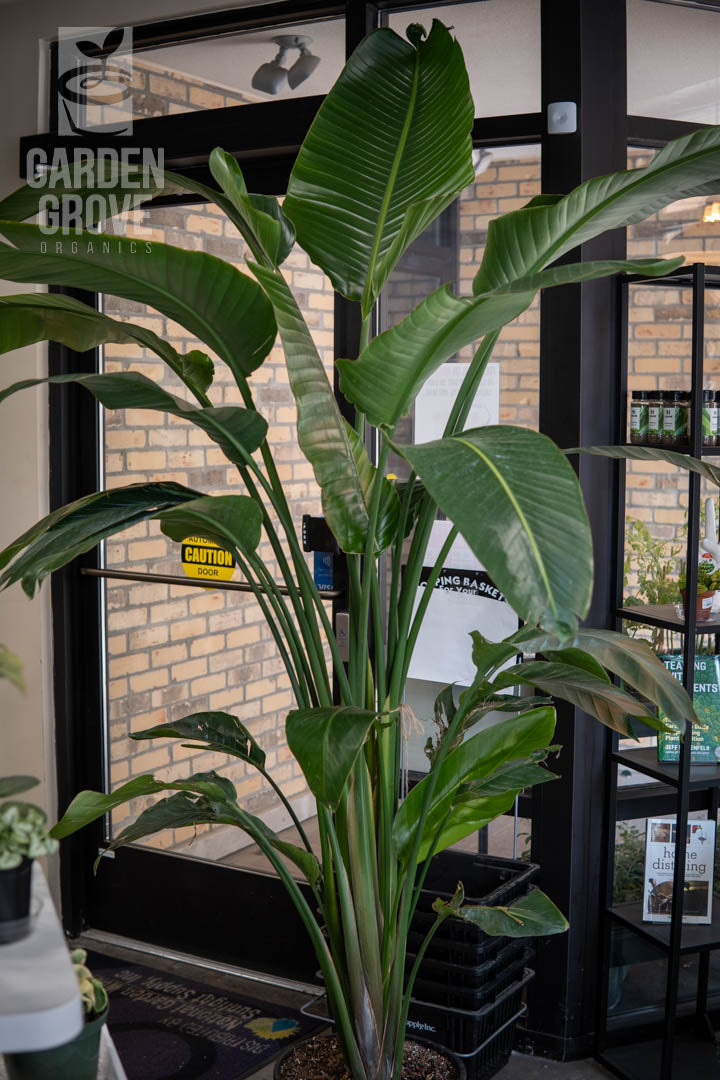Description
The bird of paradise plant, also known as Strelitzia reginae, is a tropical plant native to South Africa. It is widely recognized for its vibrant and distinctive flowers, which resemble the plumage of a tropical bird. Here’s a description of the bird of paradise plant:
-
Growth Habit: The bird of paradise plant is a clumping perennial that forms large, fan-shaped leaves. It can reach a height of up to 5 to 6 feet (1.5 to 1.8 meters) tall, with the leaves growing on long, upright stalks.
-
Leaves: The leaves of the bird of paradise are glossy, leathery, and paddle-shaped. They are arranged in a fan-like pattern and can reach a length of about 18 to 24 inches (45 to 60 cm). The leaves are typically dark green and have a prominent midrib running down the center.
-
Flowers: The most striking feature of the bird of paradise plant is its flowers. The flowers are composed of orange and blue petals, which resemble the plumage of a tropical bird, thus giving the plant its name. The flowers emerge from a boat-shaped bract and have a distinctive shape with three upright petals and three downward-curving petals. They are long-lasting and make for excellent cut flowers.
-
Light Requirements: Bird of paradise plants thrive in bright, indirect light. They prefer a location with plenty of sunlight but can tolerate partial shade. Inadequate light may result in reduced flowering.
-
Temperature and Humidity: The bird of paradise plant prefers warm temperatures between 60°F and 70°F (15°C to 25°C). It can tolerate a range of humidity levels but generally appreciates moderate to high humidity. In drier indoor environments, misting the leaves or using a humidifier can help create a more suitable environment.
-
Watering: It’s important to provide regular watering to the bird of paradise plant, allowing the soil to partially dry out between waterings. Overwatering can lead to root rot, so it’s important to ensure good drainage. During winter or periods of slower growth, reduce watering frequency.
-
Soil: Bird of paradise plants prefer well-draining soil that retains some moisture. A mix of regular potting soil with added organic matter, such as compost or peat moss, can provide a suitable growing medium.
-
Fertilization: Feed bird of paradise plants with a balanced, slow-release fertilizer during the growing season (spring and summer). Follow the instructions on the fertilizer packaging for application rates. Avoid over-fertilization, as it can cause leaf burn.
-
Pruning: Prune the bird of paradise plant to remove any dead or damaged leaves. You can also trim back old flower stalks after they have finished blooming. Pruning can help maintain a tidy appearance and promote new growth.
-
Maintenance: The bird of paradise plant is generally a low-maintenance plant. However, it may attract pests like aphids or mealybugs. Regularly inspect the plant for signs of pests and treat them accordingly. Additionally, dusting the leaves with a damp cloth can help keep them clean and free from dust buildup.
The bird of paradise plant is a stunning addition to both indoor and outdoor spaces. Its unique flowers and lush foliage make it a popular choice among plant enthusiasts. With proper care, it can thrive and bring a touch of tropical beauty to your surroundings.
Â



Reviews
There are no reviews yet.